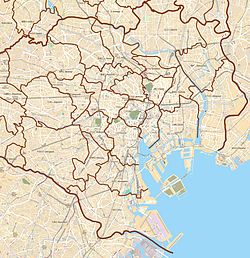Hibiya Station
Metro station in Tokyo, Japan From Wikipedia, the free encyclopedia
Hibiya Station (日比谷駅, Hibiya-eki) is a Tokyo subway station in the Yūrakuchō district of Chiyoda, Tokyo, Japan, operated by Tokyo Metro and Toei. The area around the station is generally called Hibiya, which is the southwestern corner of the Yūrakuchō district.
This article needs additional citations for verification. (May 2022) |
C09 H08 I08 Hibiya Station 日比谷駅 | ||||||||||||||||||||||||||
|---|---|---|---|---|---|---|---|---|---|---|---|---|---|---|---|---|---|---|---|---|---|---|---|---|---|---|
 Chiyoda Line ticket gates, 2019 | ||||||||||||||||||||||||||
| General information | ||||||||||||||||||||||||||
| Location | 1-5-1-saki (Tokyo Metro) 1-13-1-saki (Toei) Yūrakuchō, Chiyoda City, Tokyo Japan | |||||||||||||||||||||||||
| Operated by | Tokyo Metro Toei Subway | |||||||||||||||||||||||||
| Line(s) |
| |||||||||||||||||||||||||
| Platforms | 2 side platforms, 1 island platform | |||||||||||||||||||||||||
| Connections | Y18 JK25 JY30 Yūrakuchō | |||||||||||||||||||||||||
| Construction | ||||||||||||||||||||||||||
| Structure type | Underground | |||||||||||||||||||||||||
| Other information | ||||||||||||||||||||||||||
| Station code | C-09, H-08, I-08 | |||||||||||||||||||||||||
| History | ||||||||||||||||||||||||||
| Opened | 29 August 1964 | |||||||||||||||||||||||||
| Passengers | ||||||||||||||||||||||||||
| FY2019 | 116,808 daily (Tokyo Metro)[1] 95,622 daily (Toei Subway)[2] | |||||||||||||||||||||||||
| Services | ||||||||||||||||||||||||||
| ||||||||||||||||||||||||||
| ||||||||||||||||||||||||||
Hibiya is Tokyo Metro's 33rd busiest station in fiscal 2019, while its connected station Yūrakuchō ranks sixteenth.[1]
Lines
- Tokyo Metro Chiyoda Line (C-09)
- Tokyo Metro Hibiya Line (H-08)
- Toei Mita Line (I-08)
Yūrakuchō Station on the Tokyo Metro Yūrakuchō Line is connected to Hibiya Station by underground passageways, and it is possible to connect between the two stations without going through the ticket gates. However, the JR platforms at Yūrakuchō are fairly far from Hibiya Station and require a second ticket.
Station layout
Tokyo Metro platforms
| 1 | H Hibiya Line | for Ebisu and Naka-meguro |
| 2 | H Hibiya Line | for Ginza, Ueno, and Kita-senju TS Tobu Skytree Line for Tōbu-Dōbutsu-Kōen TN Tobu Nikko Line for Minami-Kurihashi |
| 3 | C Chiyoda Line | for Omote-sando and Yoyogi-uehara |
| 4 | C Chiyoda Line | for Otemachi, Kita-senju, Ayase, and Kita-ayase JL Jōban Line (Local) for Abiko and Toride |
Toei platforms
| 1 | I Mita Line |
|
| 2 | I Mita Line | for Otemachi, Sugamo, and Nishi-takashimadaira |
- Hibiya Line platforms, 2023
- Chiyoda Line platforms, 2023
- Mita Line platforms, 2019
- Entrance B6, in Marunouchi district.
History
The Hibiya Line station opened on 29 August 1964, the Chiyoda Line station opened on 20 March 1971, and the Mita Line station opened on 30 June 1972.[3]
The station facilities of the Hibiya and Chiyoda Lines were inherited by Tokyo Metro after the privatization of the Teito Rapid Transit Authority (TRTA) in 2004.[4]
Surrounding area
- Yūrakuchō Station (on the Tokyo Metro Yūrakuchō Line; connected via underground passages)
- Hibiya, Yūrakuchō and Ginza area
- Tokyo Imperial Palace
- Hibiya Park
- The Chiyoda City Hibiya Library
- Tokyo Takarazuka Theater
- Imperial Hotel, Tokyo
- The Peninsula Tokyo
References
External links
Wikiwand - on
Seamless Wikipedia browsing. On steroids.








